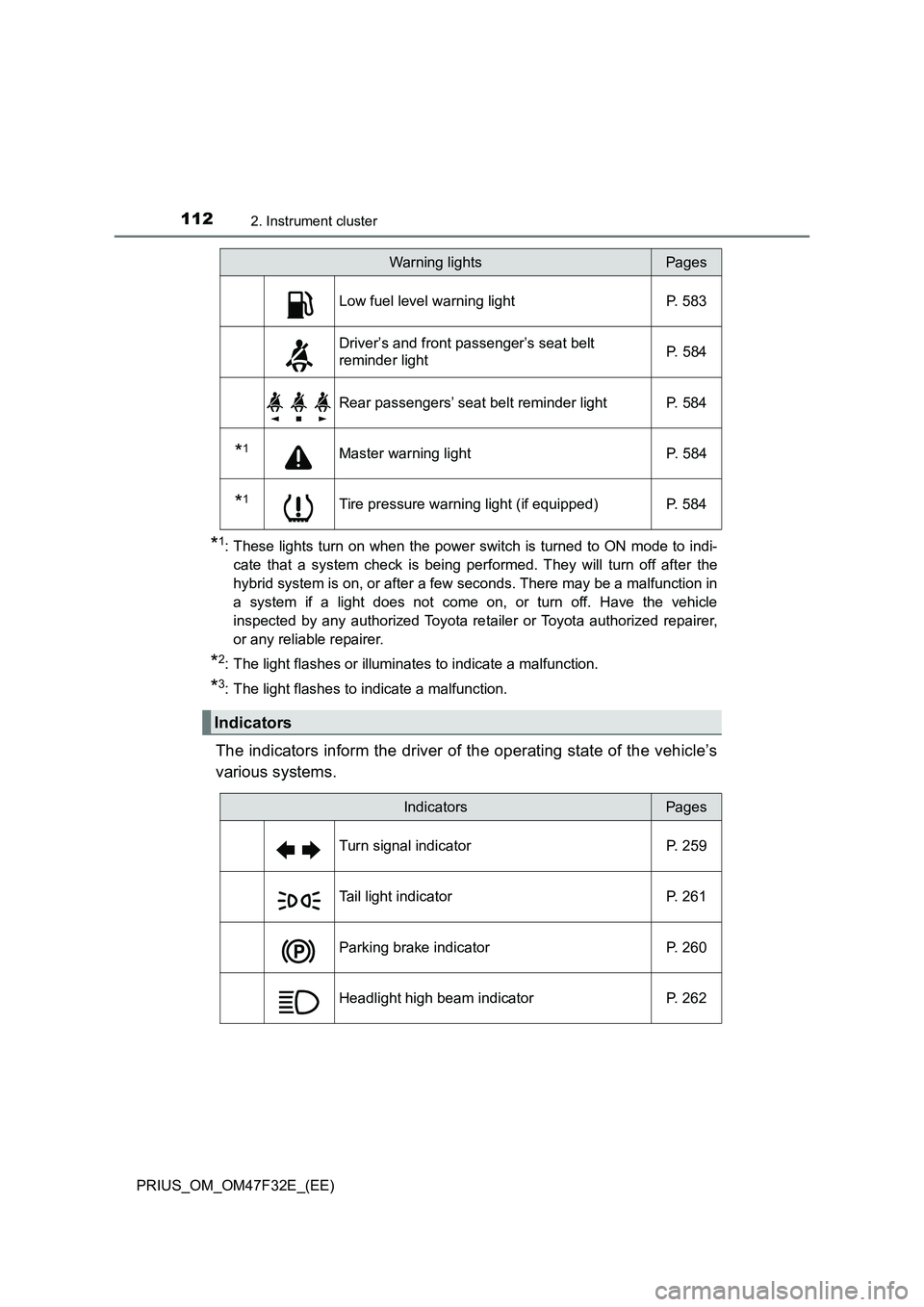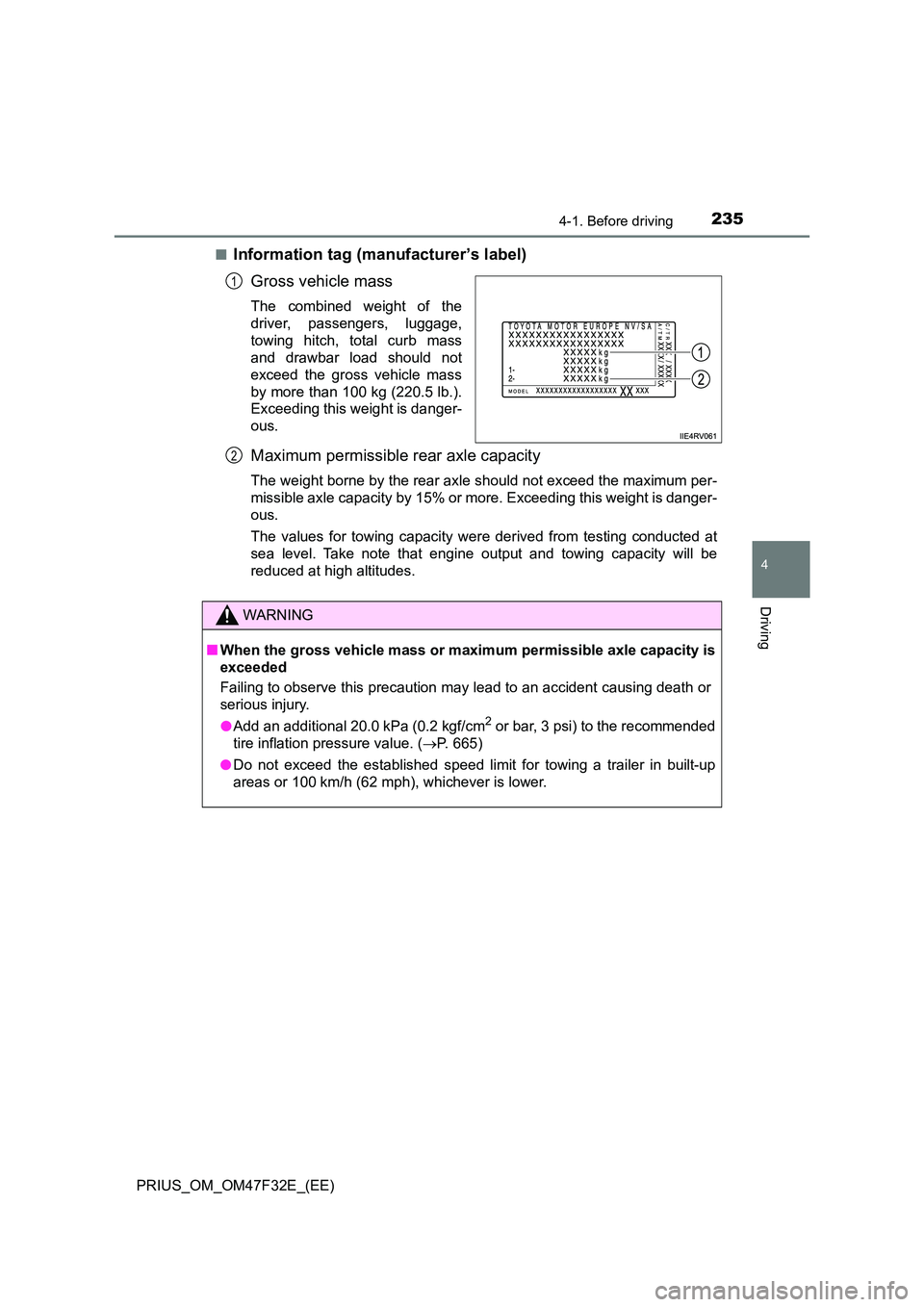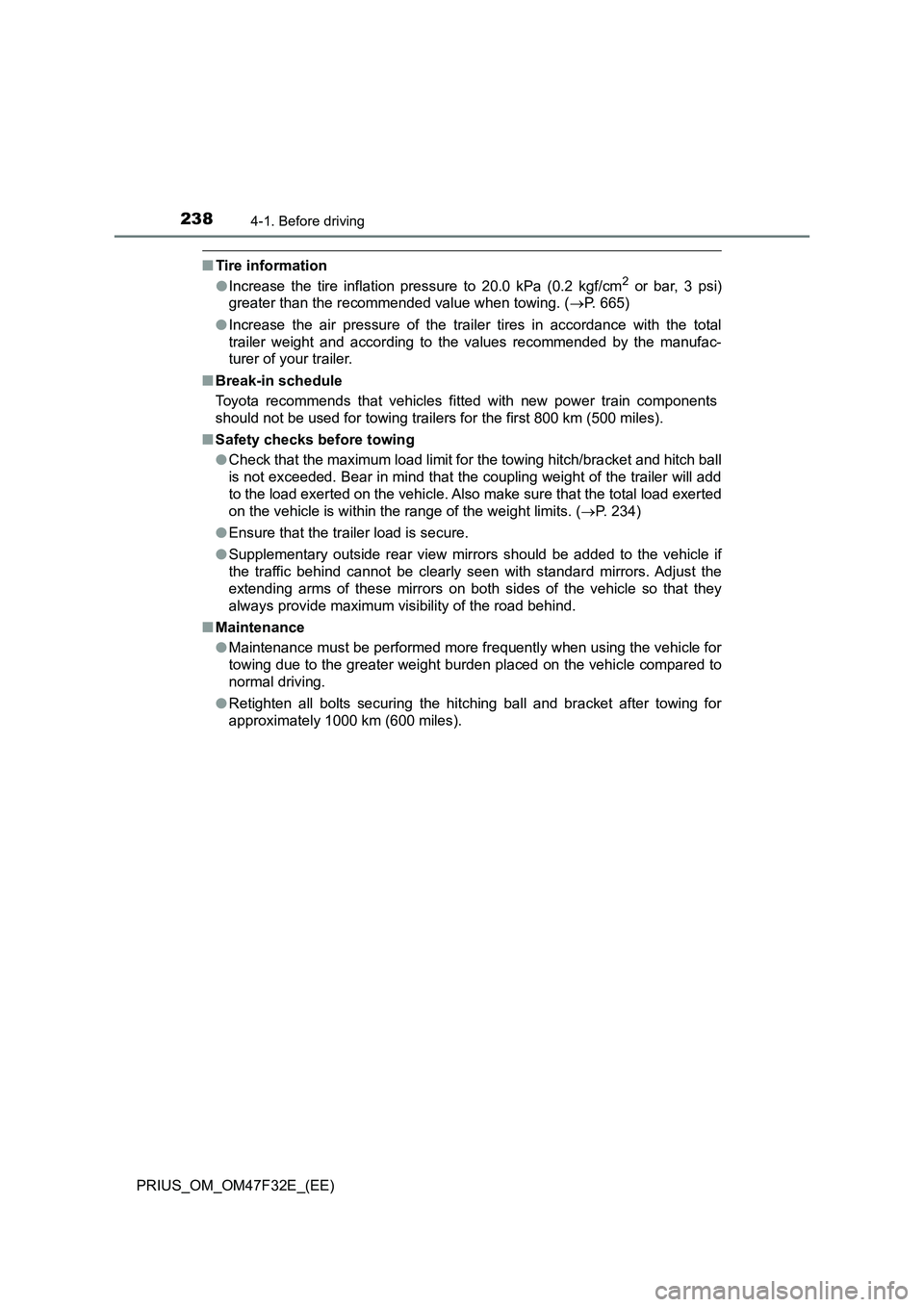2023 TOYOTA PRIUS tire pressure
[x] Cancel search: tire pressurePage 6 of 770

TABLE OF CONTENTS4
PRIUS_OM_OM47F32E_(EE)5-1. Using the air conditioning
system and defogger
Automatic air conditioning
system .............................458
Seat heaters ......................468
5-2. Using the interior lights
Interior lights list .................470
• Front interior light...........471
• Front personal lights ......471
• Rear interior light ...........472
5-3. Using the storage features
List of storage features ......473
• Glove box ......................474
• Console box ..................474
• Cup holders ...................475
• Bottle holders/
door pockets ..................476
• Auxiliary boxes ..............477
• Seat back pockets .........478
Luggage compartment
features............................479
5-4. Using the other interior
features
Other interior features ........485
• Sun visors ......................485
• Vanity mirrors ................485
• Power outlets .................486
• Wireless charger............487
• Armrest ..........................493
• Coat hooks ....................493
• Assist grips ....................4946-1. Maintenance and care
Cleaning and protecting
the vehicle exterior .......... 496
Cleaning and protecting
the vehicle interior ........... 502
6-2. Maintenance
Maintenance
requirements ................... 505
6-3. Do-it-yourself maintenance
Do-it-yourself service
precautions ..................... 508
Hood.................................. 511
Positioning a floor jack ...... 513
Engine compartment ......... 514
Tires .................................. 528
Tire inflation pressure........ 537
Wheels .............................. 539
Air conditioning filter .......... 542
Cleaning the hybrid battery
(traction battery) air intake
vent and filter .................. 545
Wiper insert
replacement .................... 550
Electronic key battery ........ 554
Checking and replacing
fuses ............................... 557
Light bulbs ......................... 561
5Interior features6Maintenance and care
Page 17 of 770

15Pictorial index
PRIUS_OM_OM47F32E_(EE)Windshield wipers . . . . . . . . . . . . . . . . . . . . . . . . . . . . . . . . . P. 271
Precautions against winter season . . . . . . . . . . . . . . . . . . . . . P. 452
Precautions against car wash (vehicles with rain-sensing
windshield wipers) . . . . . . . . . . . . . . . . . . . . . . . . . . . . . . . . . . P. 498
Replacing the wiper insert . . . . . . . . . . . . . . . . . . . . . . . . . . . . P. 550
Fuel filler door . . . . . . . . . . . . . . . . . . . . . . . . . . . . . . . . . . . . P. 277
Refueling method . . . . . . . . . . . . . . . . . . . . . . . . . . . . . . . . . . P. 277
Fuel type/fuel tank capacity . . . . . . . . . . . . . . . . . . . . . . . . . . . P. 657
Tires . . . . . . . . . . . . . . . . . . . . . . . . . . . . . . . . . . . . . . . . . . . . P. 528
Tire size/inflation pressure . . . . . . . . . . . . . . . . . . . . . . . . . . . . P. 665
Winter tires/tire chain . . . . . . . . . . . . . . . . . . . . . . . . . . . . . . . . P. 452
Checking/rotation/tire pressure warning system
*1 . . . . . . . . . P. 528
Coping with flat tires . . . . . . . . . . . . . . . . . . . . . . . . . . . . P. 598, 618
Hood . . . . . . . . . . . . . . . . . . . . . . . . . . . . . . . . . . . . . . . . . . . . P. 511
Opening . . . . . . . . . . . . . . . . . . . . . . . . . . . . . . . . . . . . . . . . . . P. 511
Engine oil . . . . . . . . . . . . . . . . . . . . . . . . . . . . . . . . . . . . . . . . . P. 658
Coping with overheat . . . . . . . . . . . . . . . . . . . . . . . . . . . . . . . . P. 645
Headlights/front position lights/
daytime running lights . . . . . . . . . . . . . . . . . . . . . . . . . . . . . P. 261
Front fog lights/rear fog light
*2 . . . . . . . . . . . . . . . . . . . . . . P. 270
Turn signal lights . . . . . . . . . . . . . . . . . . . . . . . . . . . . . . . . . . P. 259
Tail lights . . . . . . . . . . . . . . . . . . . . . . . . . . . . . . . . . . . . . . . . P. 261
License plate lights . . . . . . . . . . . . . . . . . . . . . . . . . . . . . . . . P. 261
Back-up light
*2
Shifting the shift lever to R. . . . . . . . . . . . . . . . . . . . . . . . . . . . P. 253
4
5
6
7
Light bulbs of the exterior lights for driving
(Replacing method: P. 561, Watts: P. 667)
*1: If equipped
*2: They may be located on the opposite side depending on the target region.
8
9
10
11
12
13
Page 114 of 770

1122. Instrument cluster
PRIUS_OM_OM47F32E_(EE)
*1: These lights turn on when the power switch is turned to ON mode to indi-
cate that a system check is being performed. They will turn off after the
hybrid system is on, or after a few seconds. There may be a malfunction in
a system if a light does not come on, or turn off. Have the vehicle
inspected by any authorized Toyota retailer or Toyota authorized repairer,
or any reliable repairer.
*2: The light flashes or illuminates to indicate a malfunction.
*3: The light flashes to indicate a malfunction.
The indicators inform the driver of the operating state of the vehicle’s
various systems.
Low fuel level warning light P. 583
Driver’s and front passenger’s seat belt
reminder lightP. 584
Rear passengers’ seat belt reminder light P. 584
*1Master warning light P. 584
*1Tire pressure warning light (if equipped) P. 584
Indicators
Warning lightsPages
IndicatorsPages
Turn signal indicator P. 259
Tail light indicator P. 261
Parking brake indicator P. 260
Headlight high beam indicator P. 262
Page 237 of 770

2354-1. Before driving
4
Driving
PRIUS_OM_OM47F32E_(EE)
■Information tag (manufacturer’s label)
Gross vehicle mass
The combined weight of the
driver, passengers, luggage,
towing hitch, total curb mass
and drawbar load should not
exceed the gross vehicle mass
by more than 100 kg (220.5 lb.).
Exceeding this weight is danger-
ous.
Maximum permissible rear axle capacity
The weight borne by the rear axle should not exceed the maximum per-
missible axle capacity by 15% or more. Exceeding this weight is danger-
ous.
The values for towing capacity were derived from testing conducted at
sea level. Take note that engine output and towing capacity will be
reduced at high altitudes.
1
2
WARNING
■ When the gross vehicle mass or maximum permissible axle capacity is
exceeded
Failing to observe this precaution may lead to an accident causing death or
serious injury.
● Add an additional 20.0 kPa (0.2 kgf/cm2 or bar, 3 psi) to the recommended
tire inflation pressure value. ( P. 665)
● Do not exceed the established speed limit for towing a trailer in built-up
areas or 100 km/h (62 mph), whichever is lower.
Page 240 of 770

2384-1. Before driving
PRIUS_OM_OM47F32E_(EE)
■Tire information
●Increase the tire inflation pressure to 20.0 kPa (0.2 kgf/cm2 or bar, 3 psi)
greater than the recommended value when towing. (P. 665)
●Increase the air pressure of the trailer tires in accordance with the total
trailer weight and according to the values recommended by the manufac-
turer of your trailer.
■Break-in schedule
Toyota recommends that vehicles fitted with new power train components
should not be used for towing trailers for the first 800 km (500 miles).
■Safety checks before towing
●Check that the maximum load limit for the towing hitch/bracket and hitch ball
is not exceeded. Bear in mind that the coupling weight of the trailer will add
to the load exerted on the vehicle. Also make sure that the total load exerted
on the vehicle is within the range of the weight limits. (P. 234)
●Ensure that the trailer load is secure.
●Supplementary outside rear view mirrors should be added to the vehicle if
the traffic behind cannot be clearly seen with standard mirrors. Adjust the
extending arms of these mirrors on both sides of the vehicle so that they
always provide maximum visibility of the road behind.
■Maintenance
●Maintenance must be performed more frequently when using the vehicle for
towing due to the greater weight burden placed on the vehicle compared to
normal driving.
●Retighten all bolts securing the hitching ball and bracket after towing for
approximately 1000 km (600 miles).
Page 308 of 770

3064-5. Using the driving support systems
PRIUS_OM_OM47F32E_(EE)• While driving on a curve and for a few seconds after driving on a curve
• If your vehicle is skidding
• If the wheels are misaligned
• If a wiper blade is blocking the front camera
• The vehicle is being driven at extremely high speeds
• When driving on a hill
• If the radar sensor or front camera is misaligned
●In some situations such as the following, sufficient braking force may not be
obtained, preventing the system from performing properly:
• If the braking functions cannot operate to their full extent, such as when
the brake parts are extremely cold, extremely hot, or wet
• If the vehicle is not properly maintained (brakes or tires are excessively
worn, improper tire inflation pressure, etc.)
• When the vehicle is being driven on a gravel road or other slippery sur-
face
■If VSC is disabled
●If VSC is disabled (P. 443), the pre-collision brake assist and pre-collision
braking functions are also disabled.
●The PCS warning light will turn on and “VSC Turned Off Pre-Collision Brake
System Unavailable” will be displayed on the multi-information display. • If the front of the vehicle is raised or
lowered
Page 313 of 770

3114-5. Using the driving support systems
4
Driving
PRIUS_OM_OM47F32E_(EE)
WARNING
●The vehicle is driven in an area where the brightness changes suddenly,
such as at the entrances and exits of tunnels, etc.
● Light from the headlights of an oncoming vehicle, the sun, etc. enters the
camera.
● The vehicle is driven on a slope.
● The vehicle is driven on a road which tilts left or right, or a winding road.
● The vehicle is driven on an unpaved or rough road.
● The traffic lane is excessively narrow or wide.
● The vehicle is extremely tilted due to carrying heavy luggage or having
improper tire pressure.
● The distance to the preceding vehicle is extremely short.
● The vehicle is moving up and down a large amount due to road conditions
during driving (poor roads or road seams).
● When driving in a tunnel or at night with the headlights off or when a head-
light is dim due to its lens being dirty or it being misaligned.
● The vehicle is struck by a crosswind.
● The vehicle is affected by wind from a vehicle driven in a nearby lane.
● The vehicle has just changed lanes or crossed an intersection.
● Tires which differ by structure, manufacturer, brand or tread pattern are
used.
● When tires of a size other than specified are installed.
● Snow tires, etc. are equipped.
● The vehicle is being driven at extremely high speeds.
Page 406 of 770

4044-5. Using the driving support systems
PRIUS_OM_OM47F32E_(EE)
NOTICE
■Preventing sensor malfunctions
● If the area around a sensor is subjected to an impact, equipment may not
operate properly due to a sensor malfunction. Have the vehicle inspected
at any authorized Toyota retailer or Toyota authorized repairer, or any reli-
able repairer.
● When using a high-pressure washer to wash the vehicle, do not spray
water directly on the sensors. The sensors may not function properly if
subjected to an impact from strong water pressure.
● When using steam to wash the vehicle, do not direct steam too close to
the sensors. The sensors may not function properly if subjected to steam.
■ Preventing unnecessary operation
In the following situations, turn the Parking Support Brake function off. The
system may operate even though there is no possibility of a collision.
● A chassis roller, chassis dynamo, free roller or similar equipment is being
used for an inspection, etc.
● The vehicle is being loaded onto a ship, truck or other transport vessel
● The suspension has been lowered or tires that have a different size than
the genuine tires are equipped
● The height of the vehicle has drastically changed due to the carried load
(the nose tilts up or down).
● A towing eyelet is installed
● When using an automatic car wash
■ Notes when washing the vehicle
P. 393